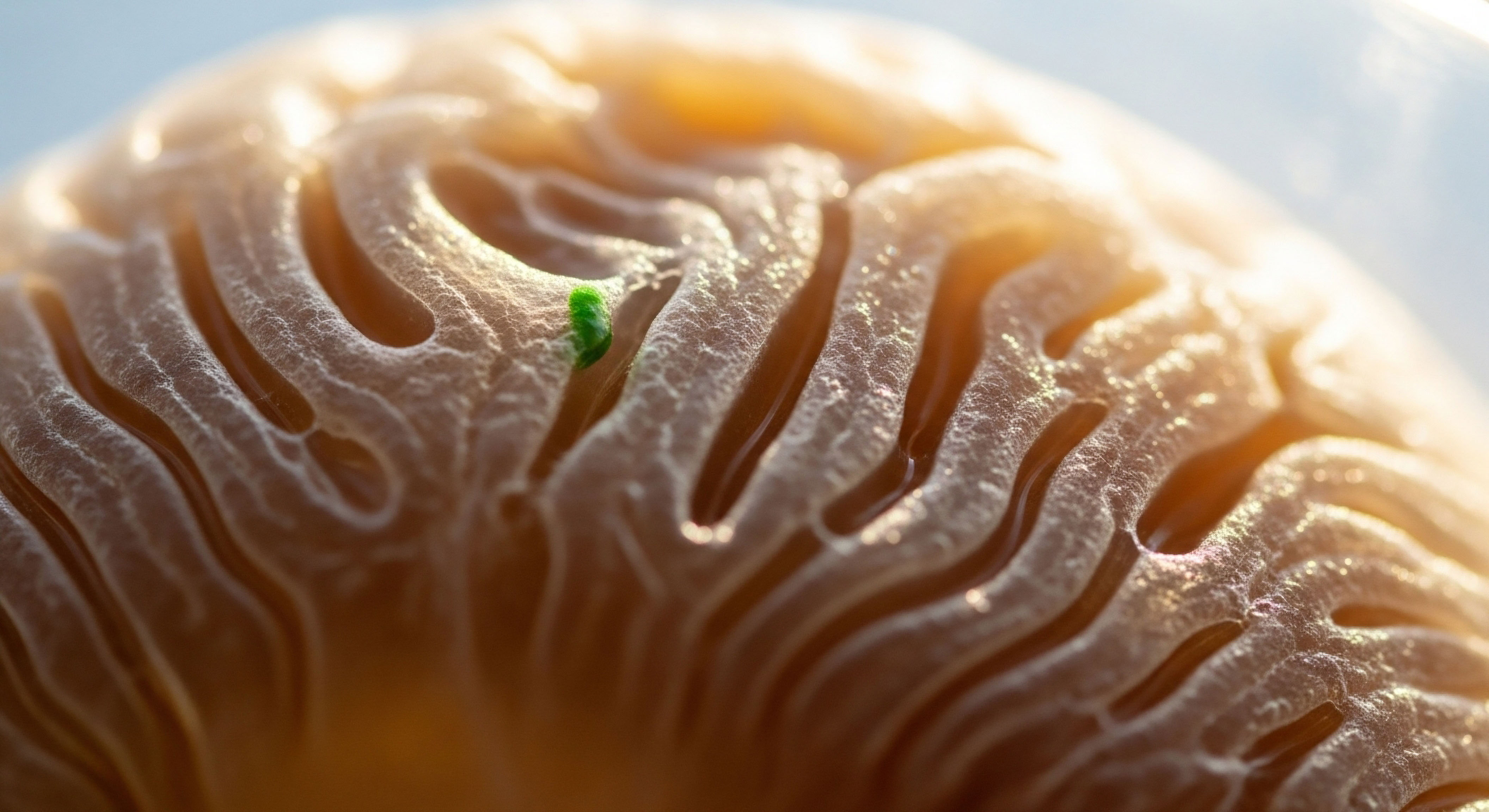

Fundamentals
You feel it as a recovery that takes longer than it used to. A nagging joint ache that persists, or a minor strain that becomes a constant companion. This lived experience of slowed healing is a direct reflection of a conversation happening within your body at a microscopic level.
Your cells are constantly communicating, orchestrating the intricate process of repair. When this communication becomes inefficient, the physical results are undeniable. The journey to reclaiming vitality begins with understanding this internal language, the dialect of cellular signaling that governs how your tissues rebuild and restore their function.
At the heart of this biological dialogue are peptides. These are small chains of amino acids, the fundamental building blocks of proteins. Think of them as short, specific messages, each carrying a precise instruction for a cell. They are the body’s native messengers, designed to initiate very specific actions.
When tissue is damaged, a cascade of these signals is released, calling forth the resources needed for repair. Peptide therapies are designed to augment this natural process, introducing specific, targeted messages to amplify the body’s own healing directives.
Peptide therapies function by introducing precise amino acid sequences that act as specific instructions to enhance the body’s innate cellular repair mechanisms.

The Lock and Key a Biological System of Action
To grasp how a peptide works, envision a lock and a key. Every cell has receptors on its surface, which function like locks. A peptide, with its unique shape and amino acid sequence, is the key. Only a specific peptide key can fit into a specific cellular lock.
When the peptide binds to its receptor, it ‘unlocks’ the cell, initiating a chain of events inside. This is a signaling pathway. This precise interaction ensures that the peptide’s message is delivered only to the intended cells, avoiding widespread, unintended effects.
This targeted communication is what makes these protocols so efficient. A peptide designed for tissue repair will bind to receptors on fibroblasts, the cells responsible for producing collagen, or on endothelial cells, which form new blood vessels. Once the message is received, the cell begins its specialized task. This elegant system of specificity is the foundation of cellular repair and the mechanism through which peptide therapies exert their influence.

What Are Cellular Signaling Pathways?
A cellular signaling pathway is the sequence of events that occurs after a peptide binds to its receptor. It is the internal relay race that carries the initial message from the cell’s surface to its nucleus, where the cell’s genetic instructions are stored.
This relay involves a series of proteins and molecules that activate one another in a domino-like effect. The final step in this pathway often involves activating transcription factors, which are proteins that can turn specific genes on or off.
For tissue repair, the activated genes are those that code for essential regenerative materials. This could include:
- Collagen A primary structural protein that provides the framework for new tissue.
- Growth factors Proteins that stimulate cell growth, proliferation, and differentiation.
- Angiogenic factors Molecules that promote the formation of new blood vessels, which are critical for supplying oxygen and nutrients to the healing site.
By activating these pathways, peptide therapies essentially provide a clear, amplified set of instructions for the cell to begin the work of rebuilding. They are not introducing a foreign process; they are enhancing a conversation that is already taking place, making it more coherent and effective.


Intermediate
Understanding the fundamental concept of peptides as cellular messengers opens the door to a more detailed exploration of their clinical application. Different classes of peptides are utilized to achieve distinct therapeutic goals, each interacting with unique signaling pathways.
The true sophistication of these protocols lies in selecting the right peptide to deliver a precise message to a specific system, thereby recalibrating the body’s regenerative response. Two prominent categories in wellness and recovery protocols are Growth Hormone Secretagogues and tissue-specific regenerative peptides.

Growth Hormone Secretagogues the Systemic Signal
Growth Hormone Secretagogues (GHS) are peptides designed to stimulate the pituitary gland to release Human Growth Hormone (HGH). HGH is a foundational hormone for repair and metabolism throughout the body. Peptides like Ipamorelin and CJC-1295 operate by interacting with specific receptors in the pituitary, initiating a signaling cascade that results in HGH production. This approach provides a systemic, body-wide signal for growth and repair.
The mechanism unfolds in a highly coordinated manner:
- CJC-1295 This peptide is an analog of Growth Hormone-Releasing Hormone (GHRH). It binds to GHRH receptors on the pituitary cells. This binding activates a G-protein, which in turn stimulates an enzyme called adenylyl cyclase.
- The cAMP Pathway Adenylyl cyclase increases the intracellular concentration of a secondary messenger called cyclic adenosine monophosphate (cAMP). cAMP then activates Protein Kinase A (PKA), a crucial enzyme that phosphorylates transcription factors in the nucleus.
- Ipamorelin This peptide acts on a different receptor, the ghrelin receptor (also known as the GHS-R1a). Its binding also initiates a signaling cascade, albeit through a complementary pathway, which synergistically enhances the signal for HGH release.
- HGH Synthesis and Release The activated transcription factors promote the synthesis and release of HGH from the pituitary gland into the bloodstream. From there, HGH travels throughout the body, promoting cellular repair, muscle growth, and metabolic efficiency.
This dual-receptor strategy, using both the GHRH and ghrelin pathways, produces a more robust and naturalistic release of HGH compared to stimulating only one pathway. It respects the body’s physiological rhythms, leading to a balanced and sustained elevation of this vital repair hormone.
By engaging multiple pituitary receptors, growth hormone secretagogues create a synergistic and pulsatile release of growth hormone, closely mimicking the body’s natural output.

Tissue Specific Peptides the Localized Command
While GHS peptides provide a broad signal for systemic repair, other peptides are known for their highly localized effects on specific tissues. A prime example is BPC-157, a pentadecapeptide derived from a protein found in gastric juice. Its primary role is to accelerate the healing of various tissues, including muscle, tendon, ligament, and the gastrointestinal tract. BPC-157’s influence is multifaceted, activating several key signaling pathways directly at the site of injury.

How Does BPC-157 Direct Tissue Repair?
BPC-157 orchestrates a localized healing response by engaging pathways that control blood vessel formation, cell migration, and structural protein synthesis. It does not command a single action but rather initiates a coordinated symphony of regenerative processes. One of its most significant mechanisms involves the Vascular Endothelial Growth Factor (VEGF) pathway.
VEGF is a critical signaling protein that promotes angiogenesis, the formation of new blood vessels. Healing tissue requires a robust blood supply to deliver oxygen, nutrients, and immune cells. BPC-157 has been shown to increase the expression of the VEGF receptor 2 (VEGFR2).
This upregulation makes the endothelial cells more sensitive to VEGF, leading to the activation of the VEGFR2-Akt-eNOS signaling pathway. This cascade results in the production of nitric oxide (NO), a molecule that improves blood flow and is essential for vascular health and tissue regeneration.
Furthermore, BPC-157 influences the Focal Adhesion Kinase (FAK) signaling pathway. FAK is a protein that plays a central role in cell migration and adhesion, processes that are fundamental to wound healing. By activating FAK, BPC-157 encourages fibroblasts to move into the injured area and begin producing collagen, the scaffold upon which new tissue is built.
| Peptide Class | Primary Target | Key Signaling Pathway | Primary Biological Outcome |
|---|---|---|---|
| Growth Hormone Secretagogues (e.g. CJC-1295/Ipamorelin) | Anterior Pituitary Gland | GHRH-R/Ghrelin-R -> cAMP/PKA | Systemic release of Human Growth Hormone |
| Tissue Repair Peptides (e.g. BPC-157) | Localized Injured Tissue (e.g. Endothelial Cells, Fibroblasts) | VEGFR2-Akt-eNOS / FAK-Paxillin | Increased angiogenesis and localized tissue regeneration |


Academic
A sophisticated analysis of peptide therapies moves beyond linear pathway descriptions to a systems-biology perspective. The remarkable efficacy of certain regenerative peptides, such as BPC-157, is rooted in their pleiotropic nature. They function as upstream modulators, initiating a cascade of events across multiple, interconnected signaling networks.
The peptide does not simply flip a single switch; it recalibrates an entire circuit board of cellular communication, creating a pro-regenerative environment. The core of this action can be understood by examining the peptide’s role as a stabilizer of cellular integrity and a promoter of adaptive signaling.

The FAK-Paxillin Axis a Nexus for Cytoskeletal Reorganization
At the molecular level, tissue repair is a function of cellular mechanics, migration, and adhesion. The Focal Adhesion Kinase (FAK) signaling pathway is a central control point for these processes. FAK is a non-receptor tyrosine kinase that becomes activated at sites of integrin clustering, where cells physically connect to the extracellular matrix (ECM). Following injury, the ability of fibroblasts and endothelial cells to migrate into the damaged area is paramount.
BPC-157 has been demonstrated to dose-dependently increase the phosphorylation of both FAK and its downstream binding partner, paxillin. This phosphorylation event is the critical activation step. Activated FAK-paxillin complexes serve as docking sites for a host of other signaling proteins, effectively forming a communication hub.
This hub integrates signals from the ECM with intracellular actin dynamics, governing the cell’s ability to move and exert traction. The activation of this axis by BPC-157 directly accelerates fibroblast migration and adhesion, which are the rate-limiting steps in wound closure and collagen deposition. This is a direct molecular explanation for the peptide’s observed ability to speed up tendon and ligament healing.

VEGFR2 Upregulation and the Angiogenic Response
The process of angiogenesis is fundamental to repair, particularly in tissues with poor intrinsic vascularization like tendons. BPC-157’s pro-angiogenic effect is exceptionally potent. Research indicates that it upregulates the expression of Vascular Endothelial Growth Factor Receptor 2 (VEGFR2), the primary receptor mediating the angiogenic effects of VEGF-A. This upregulation sensitizes endothelial cells to even low ambient levels of VEGF, amplifying the signal for neovascularization.
The downstream signaling from VEGFR2 activation proceeds through the PI3K/Akt pathway, culminating in the phosphorylation and activation of endothelial Nitric Oxide Synthase (eNOS). Activated eNOS produces nitric oxide (NO), a powerful vasodilator and signaling molecule that promotes endothelial cell survival, proliferation, and migration. The coordinated activation of the VEGFR2-Akt-eNOS axis provides a robust mechanism for restoring blood flow to ischemic or damaged tissues, a critical prerequisite for any meaningful repair.
The pleiotropic effects of regenerative peptides arise from their ability to modulate upstream signaling nodes, thereby influencing multiple downstream pathways that govern cell survival, migration, and matrix deposition.

What Is the Interplay between Signaling Pathways?
The true elegance of BPC-157’s mechanism lies in the crosstalk between these pathways. The FAK pathway and the VEGFR2 pathway are not isolated systems. FAK activation is known to be involved in VEGF-induced cell migration. By modulating both systems, BPC-157 creates a powerful synergistic effect.
The increased blood flow from VEGFR2-mediated angiogenesis delivers more nutrients and building blocks, while the FAK-mediated enhancement of fibroblast migration ensures these resources are put to use efficiently in constructing new tissue.
Furthermore, BPC-157 has been shown to modulate the expression of early growth response gene 1 (Egr-1), a transcription factor involved in matrix remodeling. This adds another layer of control, influencing the long-term structure and integrity of the repaired tissue. This multi-pronged mechanism, which combines enhanced vascularity, accelerated cell migration, and intelligent matrix remodeling, explains the peptide’s broad utility across a range of tissue injuries.
| Signaling Node | Peptide Influence | Downstream Effect | Contribution to Tissue Repair |
|---|---|---|---|
| FAK (Focal Adhesion Kinase) | Increased Phosphorylation | Activation of Paxillin and cytoskeletal reorganization | Accelerated migration of fibroblasts and endothelial cells |
| VEGFR2 | Upregulation of Receptor Expression | Sensitization to VEGF; activation of Akt-eNOS pathway | Promotion of angiogenesis and increased blood flow |
| eNOS (Endothelial Nitric Oxide Synthase) | Increased Activation via Akt | Increased Nitric Oxide (NO) production | Vasodilation, improved vascular integrity, and cell survival |
| Egr-1 (Early Growth Response 1) | Modulation of Gene Expression | Regulation of matrix metalloproteinases and collagen synthesis | Intelligent remodeling of the extracellular matrix |

Why Does Systemic Administration Have Local Effects?
An intriguing aspect of peptides like BPC-157 is their ability to exert localized effects even when administered systemically. This phenomenon suggests a homing mechanism, where the peptide preferentially accumulates at sites of injury. While the exact mechanism is still under investigation, it is hypothesized that the peptide binds to specific receptors or proteins that are upregulated in damaged or inflamed tissues.
This targeted action allows a systemically administered therapy to act almost like a localized treatment, concentrating its regenerative signaling precisely where it is needed most. This efficiency is a hallmark of advanced peptide therapeutics and a subject of ongoing academic research.

References
- Sikiric, P. et al. “Stable gastric pentadecapeptide BPC 157-NO-system relation.” Current Pharmaceutical Design, vol. 20, no. 7, 2014, pp. 1126-35.
- Chang, C. H. et al. “Pentadecapeptide BPC 157 enhances the growth hormone receptor expression in tendon fibroblasts.” Molecules, vol. 19, no. 11, 2014, pp. 19066-77.
- Seiwerth, S. et al. “BPC 157 and standard angiogenic factors. An actual link ∞ vascular endothelial growth factor (VEGF) expression and healing.” Current Pharmaceutical Design, vol. 24, no. 18, 2018, pp. 1972-1979.
- Hsieh, M. J. et al. “Therapeutic potential of pro-angiogenic BPC157 is associated with VEGFR2 activation and up-regulation.” Journal of Molecular Medicine, vol. 95, no. 6, 2017, pp. 655-667.
- Teixeira, L. S. et al. “Growth Hormone-Releasing Peptide-2 (GHRP-2), a ghrelin agonist, improves spatial memory and hippocampus neurogenesis in old mice.” Hippocampus, vol. 25, no. 11, 2015, pp. 1493-506.
- Raun, K. et al. “Ipamorelin, the first selective growth hormone secretagogue.” European Journal of Endocrinology, vol. 139, no. 5, 1998, pp. 552-61.
- Huang, T. et al. “Body protective compound-157 enhances alkali-burn wound healing in vivo and promotes proliferation, migration, and angiogenesis in vitro.” Drug Design, Development and Therapy, vol. 9, 2015, pp. 2485-99.
- Gwyer, D. et al. “Gastric pentadecapeptide BPC 157 as a therapy for sport-induced injuries.” Frontiers in Pharmacology, vol. 10, 2019, article 950.

Reflection
The knowledge of cellular signaling pathways transforms our perception of healing. It shifts the focus from passively waiting for recovery to actively understanding the biological conversations that define it. The information presented here is a map of these internal communications. It details how specific molecular messages can guide the intricate process of tissue reconstruction.
This understanding is the first, most critical step. Your personal health narrative is unique, written in the language of your own biology. Considering how these principles apply to your own journey is the beginning of a proactive and informed approach to wellness, where knowledge becomes the framework for reclaiming your body’s full potential.



